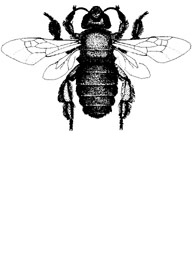 Solitary Bees are Beneficial Pollinators - June 13, 2012 Jeff Schalau, Agent, Agriculture & Natural Resources University of Arizona Cooperative Extension, Yavapai County Solitary bees are common in Arizona but rarely noticed. Solitary bees, as the name implies, nest singly either in the soil, soft wood, and plant stems. Ninety percent of all bee species are solitary types including leafcutter, digger, mason, and carpenter bees. More than likely, a homeowner would notice the signs of their presence rather than the bee itself. Examples are the circular leaf sections removed by leafcutter bees or small mounds of soil with holes at their center created by digger bees. Solitary bees are not "programmed" to sting people and there is no mass attack as might be found with social bees, hornets, and wasps. Solitary bees are not usually aggressive and their stings are considered mild. Only female bees can sting. All solitary bees, however, pack their nest cells with nectar and pollen to feed the developing larvae. Although solitary bees individually produce nests, sometimes many will nest in close proximity. This is particularly common with digger bees. Leafcutter bees are important native insects of the western United States. They cut circular-shaped pieces of leaves to construct their nest cells. Some leafcutter bees are even semi-domesticated to help produce alfalfa seed. Apparently, domestic honey bees are shy about pollinating alfalfa flowers because the flower strikes them in the head when they trip the reproductive structure. However, leafcutter bees seem to take it in stride. Their habit of leaf cutting, as well as their nesting in soft wood or plant stems, often attracts negative attention and concern of home gardeners. Digger bees generally prefer nesting in areas with morning sun exposure and well-drained soils containing little organic matter. Burrows are excavated in areas of bare ground or sparse vegetation. Solitary bees are not "programmed" to sting people and there is no mass attack as might be found with social hymenoptera such as honey bees or yellowjackets. A person might be stung if handling one roughly or if one becomes trapped in clothing. Mowing and other outdoor activities can be continued with little problem. The orchard mason bee (Osmia lignaria) is a native North American solitary bee that has been popularized in seed catalogs as a pollinator of apples, cherries, and other tree fruits. It is found throughout most of North America. The orchard mason bee is usually slightly smaller than a honey bee and a shiny dark blue in color. The actual size of the bee depends largely upon the size of the hole in which it grew. The female uses existing holes in wood for a nest. She chooses holes slightly larger than her body, usually 1/4 to 3/8 inches in diameter. The bee first places a mud plug at the bottom of the hole. When the female has provided a sufficient supply of food for the larva, she lays an egg and then seals the cell with a thin mud plug. She repeats the process and continues until the hole is nearly full. When finished, she plasters a thick mud plug at the entrance. Carpenter bees are large solitary bees that resemble bumble bees. Like mason bees, they nest in wood. Male and female carpenter bees overwinter as adults within their old nest gallery. Adults emerge in the spring (April and early May) and mate. There is one generation per year. Gallery construction is a time- and energy-consuming process, and the female will preferentially refurbish an old nest rather than excavate a new one. She bores into the wood perpendicular to the grain for one to two inches then makes a right angle turn and excavates along the wood grain for four to six inches to create a gallery (tunnel). The female excavates the gallery at the rate of about one inch in six days. Like other solitary bees, she creates a series of provisioned brood cells in the excavated gallery. Carpenter bees are often vilified because of their destructive nest habits. Solitary bees are important native insects that may become even more important as domestic honeybees are facing greater challenges. We can protect native and domestic bees by limiting our use of insecticides, especially during flowering. When choosing to use pesticides, use the least toxic and always read label precautions carefully. Follow the Backyard Gardener on Twitter – use the link on the BYG website. If you have other gardening questions, call the Master Gardener help line in the Camp Verde office at 928-554-8999 Ext. 3 or e-mail us at cottonwoodmg@yahoo.com and be sure to include your name, address and phone number. Find past Backyard Gardener columns or provide feedback at the Backyard Gardener web site: http://cals.arizona.edu/yavapai/anr/hort/byg/. |